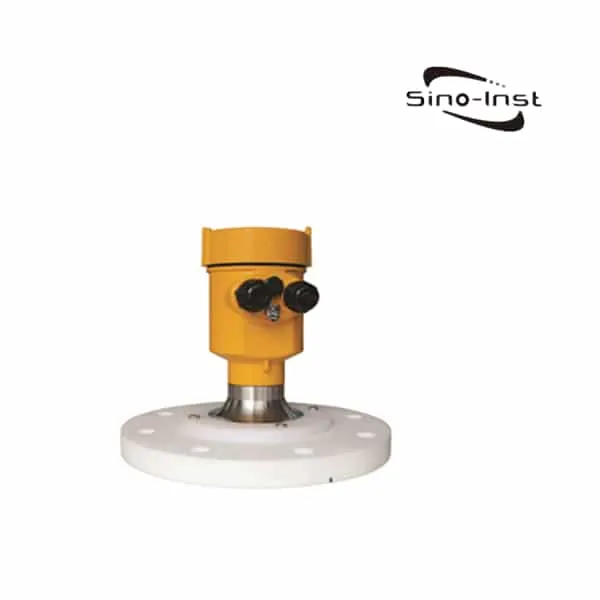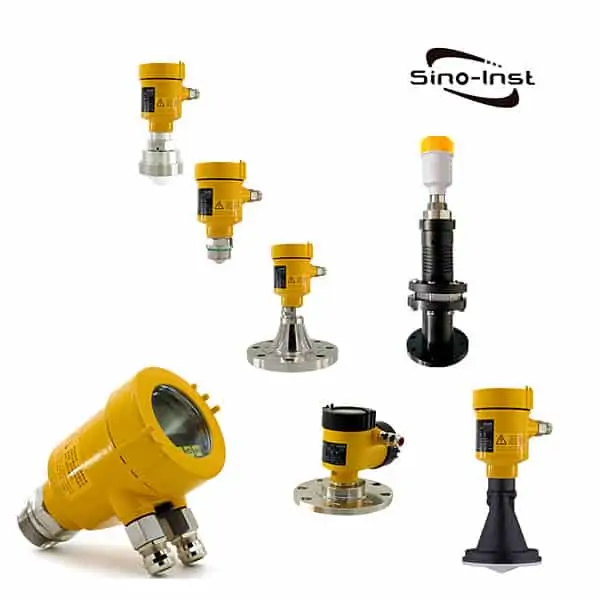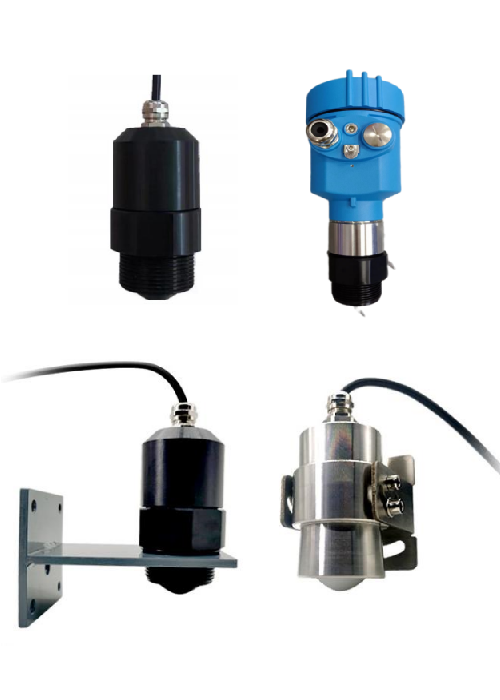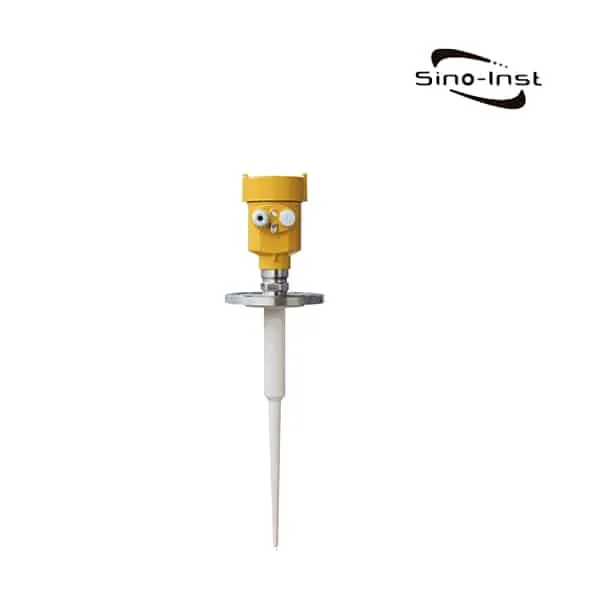Radar level measurement uses Non-contacting radar technology for Continuous level measurement. Liquids and solids are commonly measured with this measuring technique.
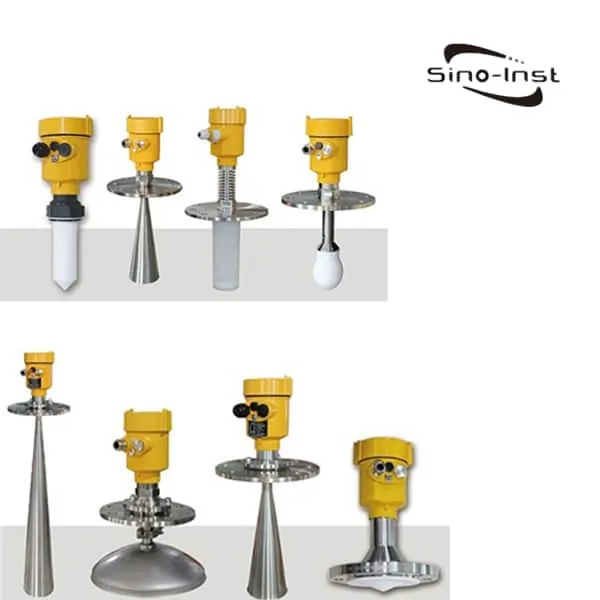
Radar level transmitters use radar technology to perform non-contact continuous level measurement. The radar level indicator converts the level into an electrical signal. The level signal output can then be utilised by other instrumentation to monitor or control. Liquids and solids are commonly measured with this measuring technique. Like: Fly ash silo. Radar level sensors are divided into: Pulsed radar technology and frequency modulated continuous wave (FMCW) radar level sensors.
Sino-Inst produces 120GHz FMCW radar level sensor, 26GHz radar level meter, 6GHz level meter.
Sino-Inst offers a variety of Radar Level Sensors for industrial level measurement. If you have any questions, please contact our sales engineers.
Featured Radar Level Transmitters
FMCW Radar Level Transmitters – 120GHz
Measuring medium: liquid;
Measuring range: 0.05m~30m;
Process connection: G1½A / 1½NPT thread / flange ≥DN50;
Process temperature: -40~80℃;
Process pressure: -0.1~0.3 MPa;
Antenna size: 32mm lens antenna;
Antenna material: PTFE
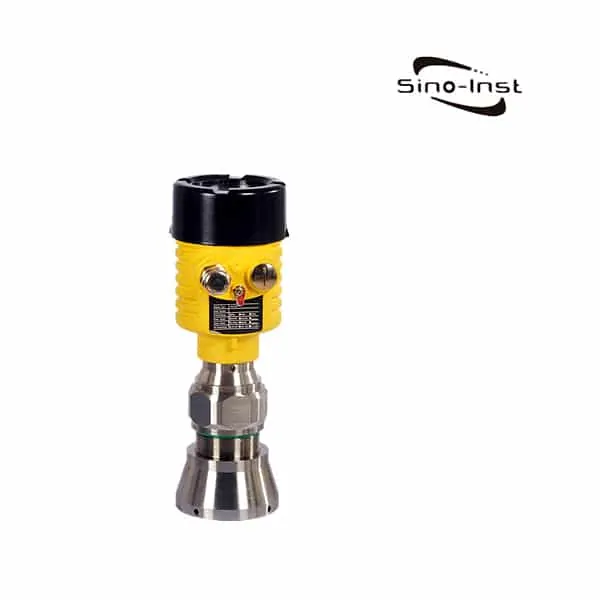
Measuring medium: liquid Measuring range: 0.05m~35m Process connection: G2A thread/flange≥DN65 Process temperature: -40~110℃ Process pressure: -0.1~1.6MPa Antenna size: 42mm lens antenna Antenna material: PTFE

Measuring medium: liquid
Measuring range: 0.1m~100m
Process connection: flange ≥DN80
Process temperature: -40~110℃
Process pressure: -0.1~0.3MPa
Antenna size: 78mm lens antenna
Antenna material: PTFE
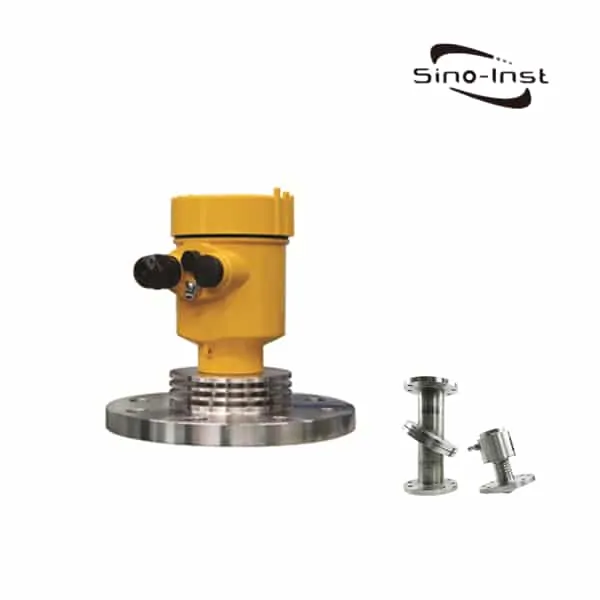
Measuring medium: liquid and Solids
Measuring range: 0.1m~120m
Process connection: flange≥DN80
Process temperature: -40~200℃; -60~1200℃
Process pressure: -0.1~2.5MPa
Antenna size: 78mm lens antenna
Antenna material: PTFE/full filling
Measuring medium: solid
Measuring range: 0.3m~150m
Process connection: flange≥DN80
Process temperature: -40~110℃
Process pressure: -0.1~0.3MPa
Antenna size: 78mm lens antenna + purging (or without purging)
Antenna material: PTFE
Radar Level Transmitters – 80 GHz
80 GHz radar sensor for continuous level measurement of liquids.
Sino-Inst also launched radar level sensor operating at 76-81 GHz.
Radar Water Level Sensor 0.05m~35m ~70m~120m;
Measure the water level of reservoirs, rivers, lakes, dams, deep wells, etc.
Radar Level Transmitters – 26 GHz
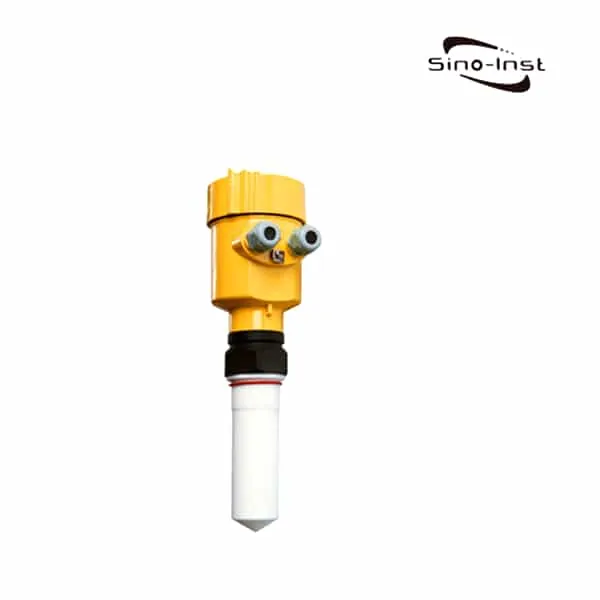
Application: various corrosive liquids
Measuring range: 10 meters
Process connection: thread, flange
Process temperature: -40~130℃
Process pressure: -0.1~0.3 MPa
Accuracy: ±5mm
Protection level: IP67
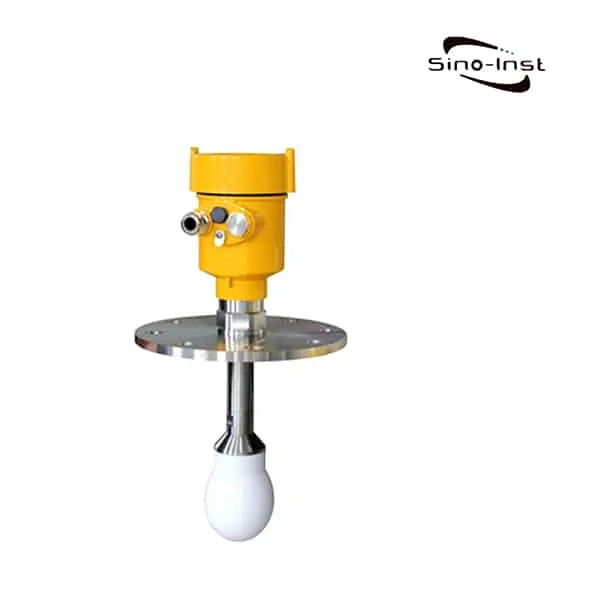
Application: temperature-resistant, pressure-resistant, slightly corrosive liquid
Measuring range: 30 meters
Process connection: thread, flange
Process temperature: -40~130℃ (standard type) / -40~250℃ (high temperature type)
Process pressure: -0.1~4.0MPa
Accuracy: ±3mm
Protection level: IP67
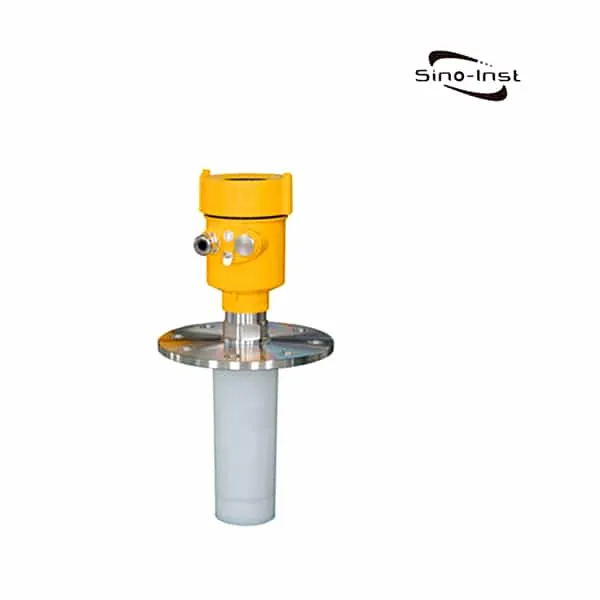
Application: corrosive liquid, steam, volatile liquid
Measuring range: 20 meters
Process connection: flange
Process temperature: -40~130℃ (standard type) / -40~250℃ (high temperature type)
Process pressure: -0.1~2.0MPa
Accuracy: ±3mm
Protection level: IP67
Frequency range: 26GHz
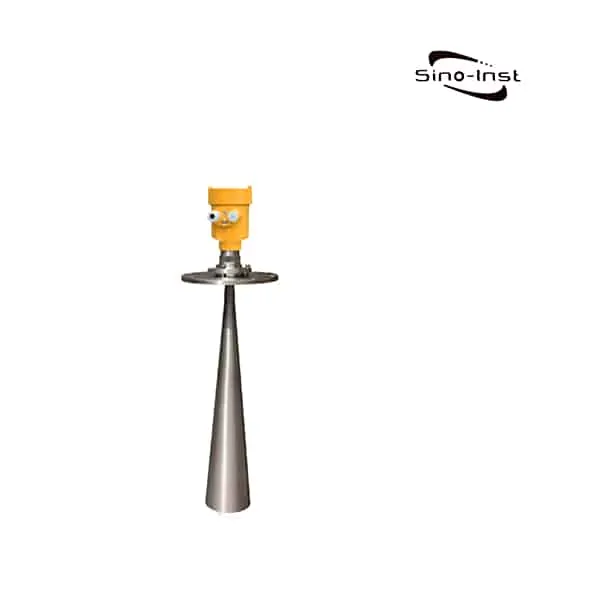
Application: solid materials, strong dust, easy to crystallize, condensation occasions
Measuring range: 70 meters
Process connection: universal flange
Process temperature: -40~130℃ (standard type) / -40~250℃ (high temperature type)
Process pressure: -0.1~4.0 MPa (flat flange) -0.1~0.3 MPa (universal flange)
Accuracy: ±15mm
Protection level: IP67
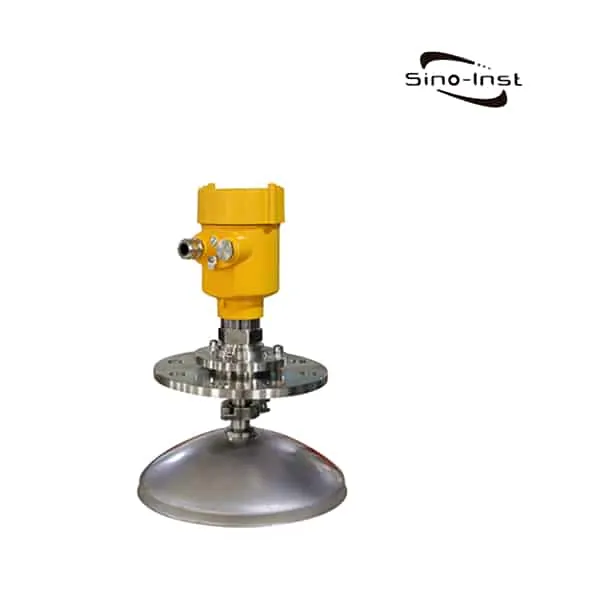
Application: solid materials, strong dust, easy to crystallize, condensation occasions
Measuring range: 80 meters
Process connection: threaded, universal flange
Process temperature: -40~130℃ (standard type) / -40~250℃ (high temperature type)
Process pressure: -0.1~0.3MPa
Accuracy: ±15mm
Protection level: IP67
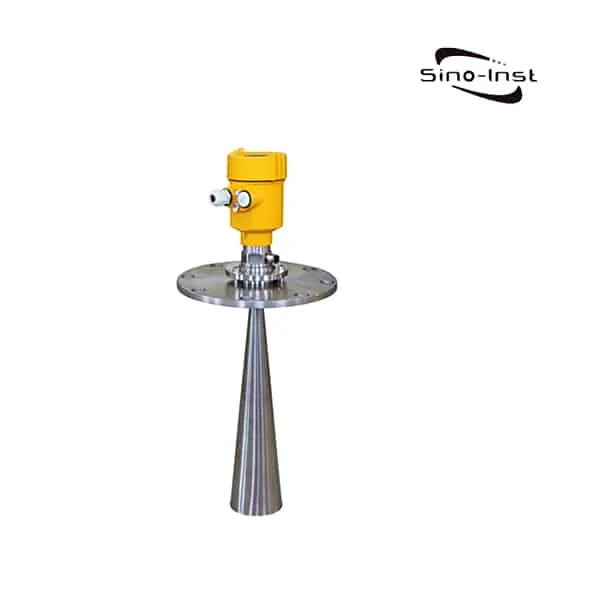
Application: solid particles, powder
Measuring range: liquid 35 meters / solid block 20 meters / solid powder 15 meters
Process connection: thread, flange
Process temperature: -40~130℃ (standard type) / -40~250℃ (high temperature type)
Process pressure: -0.1~4.0 MPa (flat flange) -0.1~0.3 MPa (universal flange)
Accuracy: ±15mm
Protection level: IP67
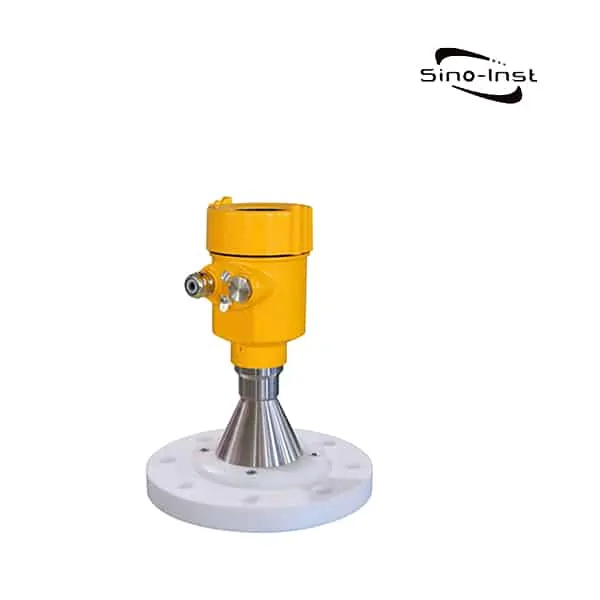
Application: sanitary liquid storage container, strong corrosive container
Measuring range: 20 meters
Process connection: flange
Process temperature: -40~130℃ (standard type) / -40~200℃ (high temperature type)
Process pressure: -0.1~4.0MPa
Accuracy: ±3mm
Protection level: IP67
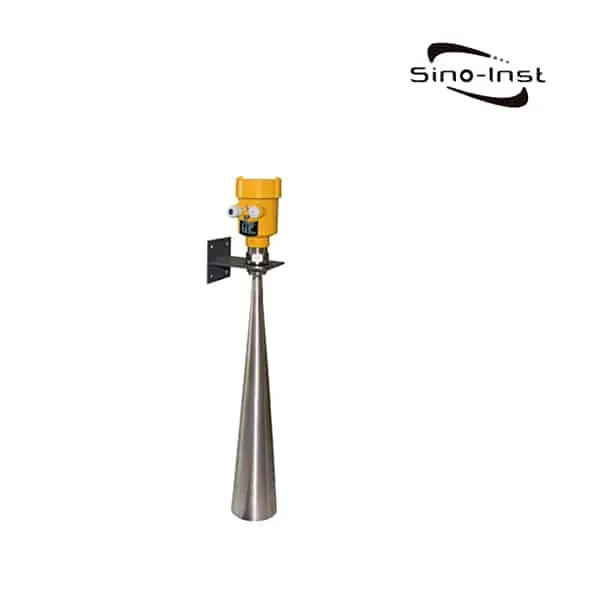
Application: rivers, lakes, shallows
Measuring range: 70 meters
Process connection: thread G1½ʺ A / bracket / flange
Process temperature: -40~100℃
Process pressure: normal pressure
Accuracy: ±10mm
Frequency range: 26GHz
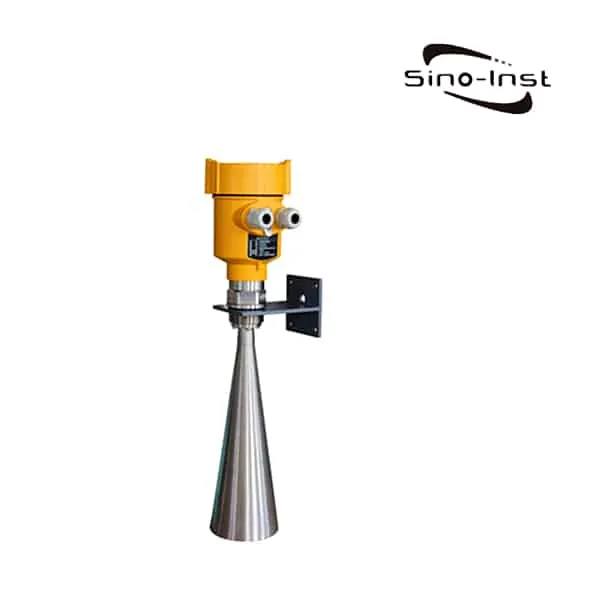
Application: rivers, lakes, shallows
Measuring range: 30 meters
Process connection: thread G1½ʺ A / bracket / flange
Process temperature: -40~100℃
Process pressure: normal pressure
Accuracy: ±3mm
Frequency range: 26GHz
Radar Level Sensors – 6 GHz
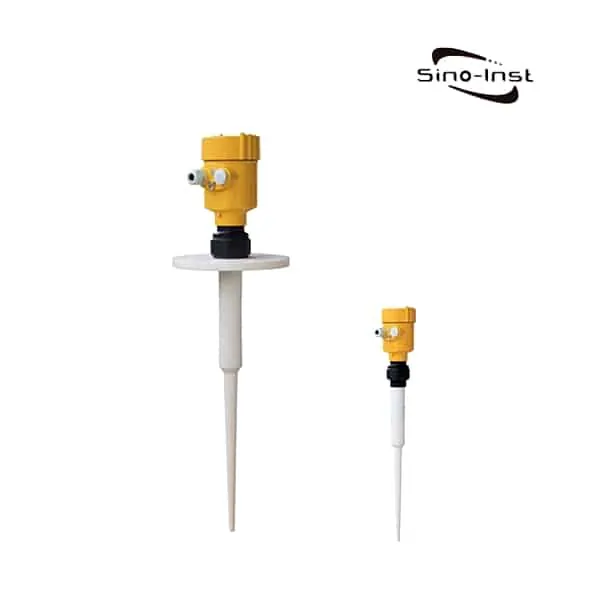
Applicable medium: liquid, slightly corrosive liquid
Application: Sewage level measurement; low volatile acid-base level measurement; slurry level measurement
Explosion-proof certification: Exia IIC T6 Ga/ Exd IIC T6 Gb
Measuring range: 20m
Antenna: Rod antenna (PP/PTFE)
Frequency: 6 GHz
Process temperature: (-40~130)℃
Applicable medium: liquid, especially suitable for strong corrosive liquid
Application: pressure level measurement; sewage level measurement; volatile acid-base level measurement; slurry level measurement
Explosion-proof certification: Exia IIC T6 Ga/Exd IIC T6 Gb
Measuring range: 20m
Antenna: Rod antenna (PTFE)
Frequency: 6 GHz
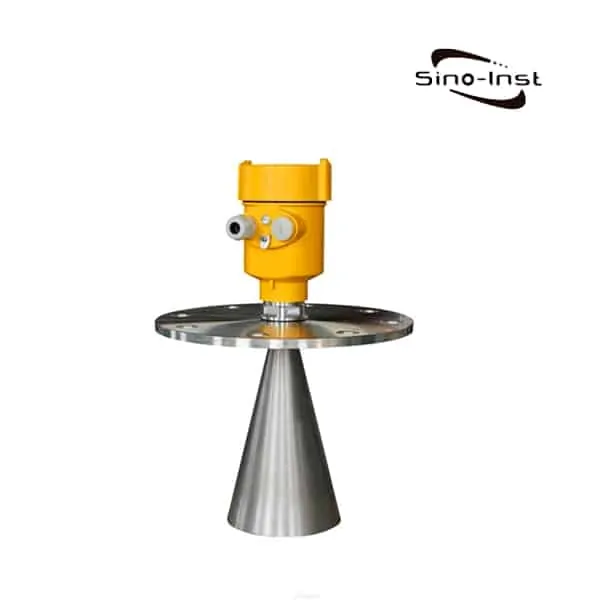
Applicable medium: liquid, especially pressure and volatile liquid
Application: crude oil, light oil level measurement; aluminum hydroxide level measurement; raw coal, limestone storage level measurement; coke level measurement
Explosion-proof certification: Exia IIC T6 Ga/ Exd IIC T6 Gb
Measuring range: 35m
Antenna: Horn antenna
Frequency: 6 GHz
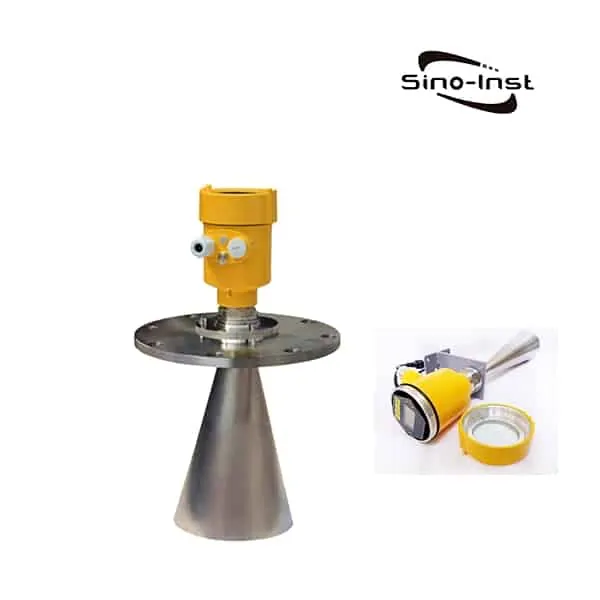
Applicable medium: solid particles or blocks, not suitable for solid powder
Application: Lime block measurement; raw coal measurement
Explosion-proof certification: Exia IIC T6 Ga/ Exd IIC T6 Gb
Measuring range: 35m
Antenna: Horn antenna
Frequency: 6 GHz
Process temperature: -40~130℃(standard type)/-40~250℃(high temperature type)
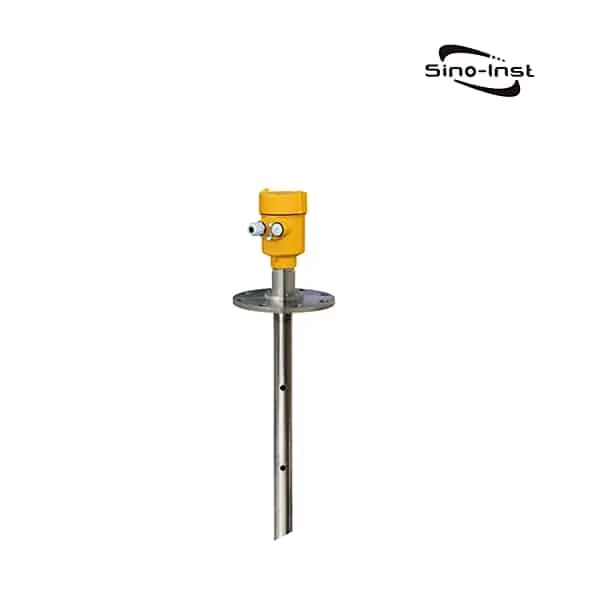
Applicable medium: liquid, especially low-dielectric constant, slightly viscous, agitated liquid
Application: 20% flour slurry tank measurement; liquid measurement with stirring
Explosion-proof certification: Exia IIC T6 Ga/Exd IIC T6 Gb
Measuring range: 20m
Antenna: Horn antenna
Frequency: 6 GHz
Process temperature: -40~130℃(standard type)/-40~250℃(high temperature type)
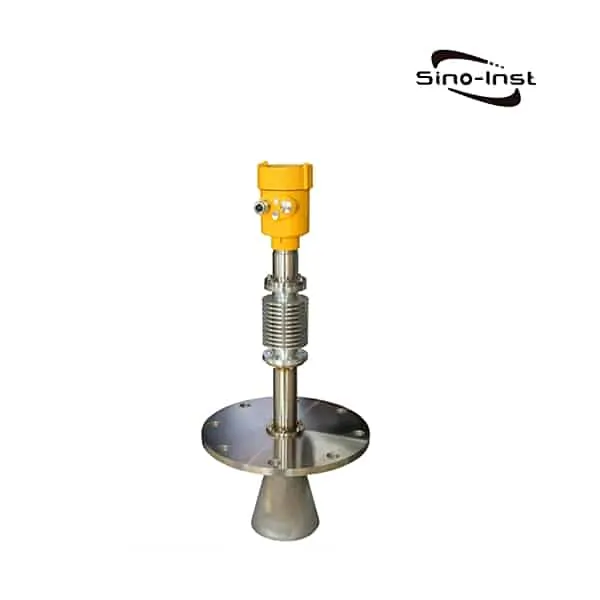
Applicable medium: solid, especially medium measurement in high temperature environment
Application: Blast furnace level measurement
Explosion-proof certification: Exia IIC T6 Ga/Exd IIC T6 Gb
Measuring range: 15m
Antenna: Horn antenna
Frequency: 6 GHz
Process temperature: (-40~400)℃
Extended Reading: What is level transmitter working principle?
Features of Radar Level Measurement
- Radar level gauge can measure liquid and solid media. For example: crude oil, slurry, raw coal, pulverized coal, volatile liquids, etc.;
- Can be measured in vacuum can measure all media with a dielectric constant> 1.2. Measuring range up to 150m;
- The power supply and output signal pass a two-core cable (loop circuit), using 4…20mA output or digital signal output;
- Non-contact measurement and installation are convenient and extremely stable materials are used. It is accurate and reliable with a resolution of up to 1mm;
- Not affected by noise, steam, dust, vacuum and other working conditions;
- Not subject to changes in medium density and temperature. Process pressure can reach 400bar, medium temperature can reach -200℃ to 800℃;
- There are various installation methods to choose from: Top installation. Side installation. Bypass pipe installation. And waveguide installation;
- Debugging can be selected in many ways: Using programming module debugging , equal to an analytical processing instrument. SOFT software debugging. HART handheld programmer debugging. Debugging is convenient and fast.
Extended reading: Oil-water interface measurement-Magtech magnetic level indicator
Radar Level Measurement: Measuring Principle

Very short microwave pulses with very low energy are transmitted and received through the antenna system. The radar wave runs at the speed of light. The operating time can be converted into level signals by electronic components. A special time extension method can ensure stable and accurate measurement in a very short time.
Electromagnetic waves propagate in the air at the speed of light. The distance between the radar level gauge and the surface of the material can be expressed by the following formula:
D = (1/2)*CT
In the formula:
D ———the distance between the radar level gauge and the surface of the material;
C ———Speed of light
T ———Pulse time.
Then the liquid level is: L = E-D
In the formula:
L — liquid level;
E ———The total height of the tank;
D ———Air height.
Even in the presence of false reflections, the new micro-processing technology and the unique ECHOFOX- software can accurately analyze the level echo. By inputting the size of the container, the distance value can be converted into a signal proportional to the level. The instrument can be debugged with empty positions.
Extended reading: Amazing Solutions for Continuous Liquid Level Measurement
Types of radar level transmitters
Generally speaking, we have the following two division methods for the types of radar level sensors.
1. There are two types of radar level sensor: contact and non-contact.
Also known as: Noninvasive or Invasive.
The non-contact type includes pulse radar and continuous frequency modulation. The probe is usually a horn antenna, that is, a tubular antenna, but the diameter of the horn is different, and the length of the horn is different. So it looks like some speakers, and some look like tubes, but they are actually one.
In addition, the contact radar is equipped with a rod antenna, usually called a guided wave radar, which is a pulse radar in principle. You can also learn more about guided wave radar level sensors.
2. In principle, radar level sensors can be divided into three main types: Pulsed. Frequency modulated continuous wave. And guided wave radar.
Non-contact radar is called a radar level sensor, which includes two types of rod antenna and horn.The contact radar level gauge can also be called a guided wave radar level gauge. Including single rod type and single cable type, double cable type, coaxial type, etc., which includes high-frequency and low-frequency radar level gauge.
Extended Reading: Dielectric constant for radar level transmitter
Advantages of radar level measurement
- Measurement is not affected by temperature, pressure or dust
- User-friendly adjustment saves time
- Non-contact, continuous level measurement over larger ranges
- Unaffected by sludge and biomass, dust, foam, oil, grease and other coatings, uneven surfaces, turbulence, pressure, and vacuum
- Single frequency radar level sensors for liquid sensing, dual frequency radar level sensors for level measurement of aggregates, gravel, sand, coal, asphalt, and other solids
- Simple mounting and push-button calibration
Extended reading: Radar Level Sensor Working Principle
Read More about: List of Differences: Radar vs Ultrasonic Level Measurement
Disadvantages of radar level measurement
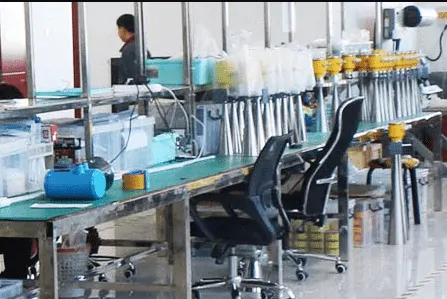
- Very sensitive to build-up on the sensor surface.
- They are very expensive. Price increases with accuracy.
Extended Reading: Low Cost Float Level Sensor for Tank Liquid Volume Monitoring
Radar VS Guided Wave Radar level measurement
Guided wave radar level sensor
Principle: The guided wave radar level sensor is a measuring instrument based on the principle of time travel. The radar wave runs at the speed of light. The running time can be converted into a level signal by electronic components. The probe sends out high-frequency pulses and propagates along the cable probe. When the pulse meets the surface of the material, it is reflected back and received by the receiver in the instrument. The distance signal is converted into a level signal.
Extended Reading: Guided-wave radar (GWR) level transmitter working principle
Is there any difference between them?
- Different ways of contact:
Radar level gauges are non-contact. Guided wave level gauges are contact-type. That is to say, the guided wave type cannot be used in the occasions where food grade requirements are high. - The working medium is different: Guided wave radar level gauges also need to consider the corrosiveness and adhesion of the medium. Moreover, the installation and maintenance of guided wave radars that are too long are more difficult. In the case of low dielectric constant, the measurement principle of radar or guided wave radar is based on the difference in dielectric constant. Since the waves emitted by ordinary radar are divergent, when the dielectric constant is too low, the signal is too weak to measure. Stable. The guided wave radar wave propagates along the probe. The signal is relatively stable. In addition, the general guided wave radar also has a bottom detection function, which can be corrected according to the measured value of the bottom echo signal to make the signal more stable and accurate.
- Selection is different: Ordinary radars can be used interchangeably. Guided wave radars cannot be used interchangeably due to the fixed length of the probe (cable) according to the original working conditions. The selection of guided wave radars is more troublesome than ordinary radars.
- Different measuring ranges: Ordinary radar is more commonly used on 30 and 40m tanks, and can even measure 150m. Guided wave radar also needs to consider the force of the probe (cable). It is also because of the force that the measurement distance of the guided wave radar is generally not very long. However, the guided wave radar has obvious advantages in some special working conditions, such as stirring in the tank and large medium fluctuations. The measured value of the guided wave radar fixed at the bottom of such working conditions is more stable than that of the flexible radar. There are also small tanks. For level measurement, due to the small installation measurement space (or many interferences in the tank), general radar is not suitable, and the advantages of guided wave radar are revealed at this time.
FAQ
What is blocking distance in Level transmitter?
The measurement dead zone refers to: when the measurement range falls into the blind zone, the deviation between the measured value and the true value does not meet the accuracy requirements set by the level gauge.
For example, a 6GHz electromagnetic radar level gauge has a wavelength of several centimeters. At a distance of several wavelengths from the probe, the waveform will reflect interference multiple times, making it difficult to identify the correct reflected wave. The distance of these several wavelengths is the blind zone of the radar level gauge.
Some level gauges do not have blind spots, such as capacitance (RF admittance)/static pressure/ray type, etc…
It should be noted that blind spots and sensitivity (resolution) are not a concept.
Extended reading: Features Of Magnetostrictive Level Transmitters
How do you calibrate radar level transmitter?
How do you calibrate radar level transmitter?
Set up the guided wave radar level transmitter
Check the configuration of the lower range value (0% level, 4 mA) and high range value (100% level, 20 mA).
Make sure that the inputted data is as per the datasheet.
For example, the lower range value is 10 inch and the high range value is 35 inch (both of it are measured from the bottom of level transmitter probe)
Fill the level transmitter chamber with water up to the 0% level.
Read the level measurement in the transmitter LCD (or in the HART communicator). Set this condition as 0% level through HART communicator.
Read the mA output of the transmitter by using a multimeter.
Adjust (if any) through the HART communicator so that the output of the transmitter (on the multimeter) is 4 mA.
Fill the level transmitter chamber with water up to the 100% level.
Read the level measurement in the transmitter LCD (or in the HART communicator). Set this condition as 100% level through HART communicator.
Read the mA output of the transmitter by using a multimeter.
Adjust (if any) through the HART communicator so that the output of the transmitter (on the multimeter) is 20 mA.
Extended reading: Non contact level measurement
Sino-Inst offers over 10 Radar level transmitters for level measurement. About 50% of these are Radar level meters, 40% is the tank level sensor.
A wide variety of radar level meters options are available to you, such as free samples, paid samples.
Sino-Inst is a globally recognized supplier and manufacturer of radar level measurement instrumentation, located in China.
Request a Quote

Wu Peng, born in 1980, is a highly respected and accomplished male engineer with extensive experience in the field of automation. With over 20 years of industry experience, Wu has made significant contributions to both academia and engineering projects.
Throughout his career, Wu Peng has participated in numerous national and international engineering projects. Some of his most notable projects include the development of an intelligent control system for oil refineries, the design of a cutting-edge distributed control system for petrochemical plants, and the optimization of control algorithms for natural gas pipelines.


